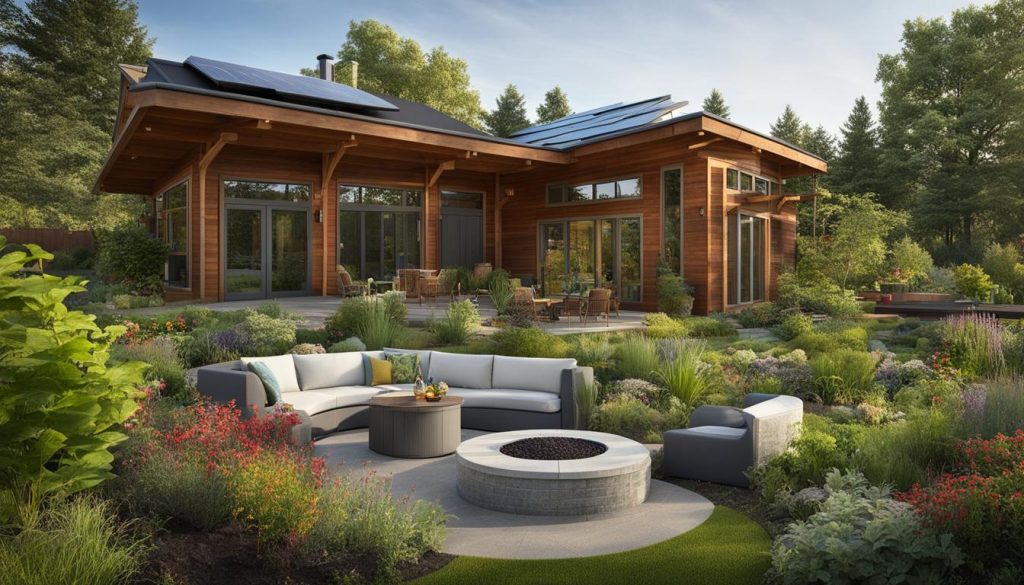Welcome to our guide on creating a sustainable landscape that can transform your outdoor space into a eco-friendly haven. With sustainable landscaping, you can achieve an attractive and functional yard while minimizing the negative impact on the environment. As professionals of sustainable living, we believe that taking care of our environment is a crucial element to a healthy and happy life. That is why we have put together this comprehensive guide to help you design your very own sustainable landscape.
Embrace Green Living in Canada
At our core, Canadians value sustainability and green living. It’s no surprise that more and more Canadians are choosing to incorporate eco-friendly practices into their daily lives, including their outdoor spaces.
Creating a sustainable landscape is a Canadian way of living that aligns with our love of nature and desire to protect the environment. By designing a sustainable landscape, we can not only enjoy the beauty of our outdoor space but also reduce our environmental impact.
At the heart of the Canadian way of living is a spirit of caring for the natural world around us. This means making choices that prioritize sustainability, even in our own backyard. With a sustainable landscape, we can contribute to a healthier planet and preserve our beautiful Canadian environment.
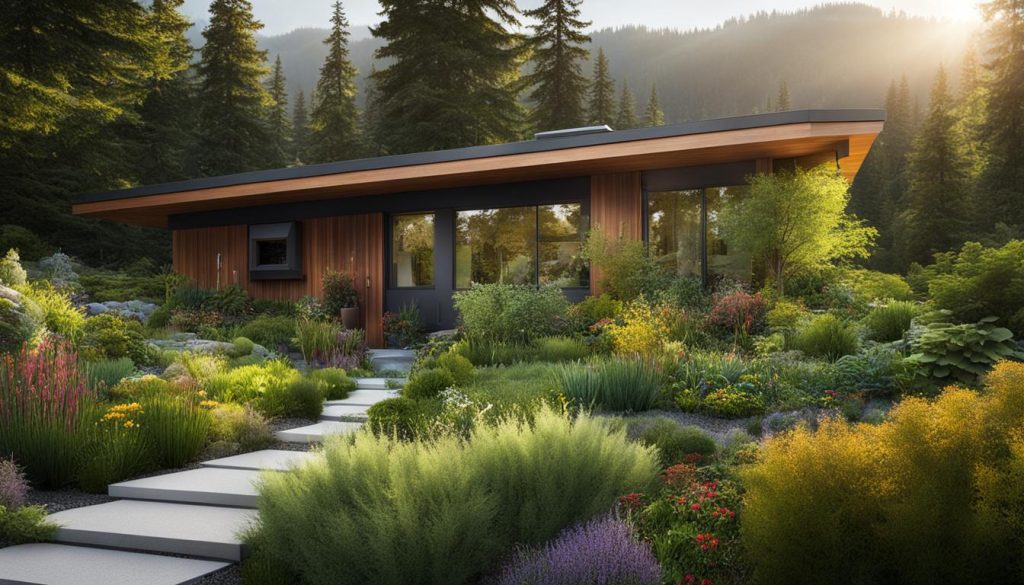
Planning the Perfect Sustainable Landscape Design
Planning is the first step towards designing a sustainable landscape. At this stage, we assess our outdoor space and set goals to achieve the desired design.
Before embarking on any landscaping project, it’s crucial to consider what we want to achieve from our outdoor space. Do we want a low-maintenance garden or a space that promotes biodiversity? Once we have a clear understanding of our goals, we can begin to design a landscape that aligns with our objectives.
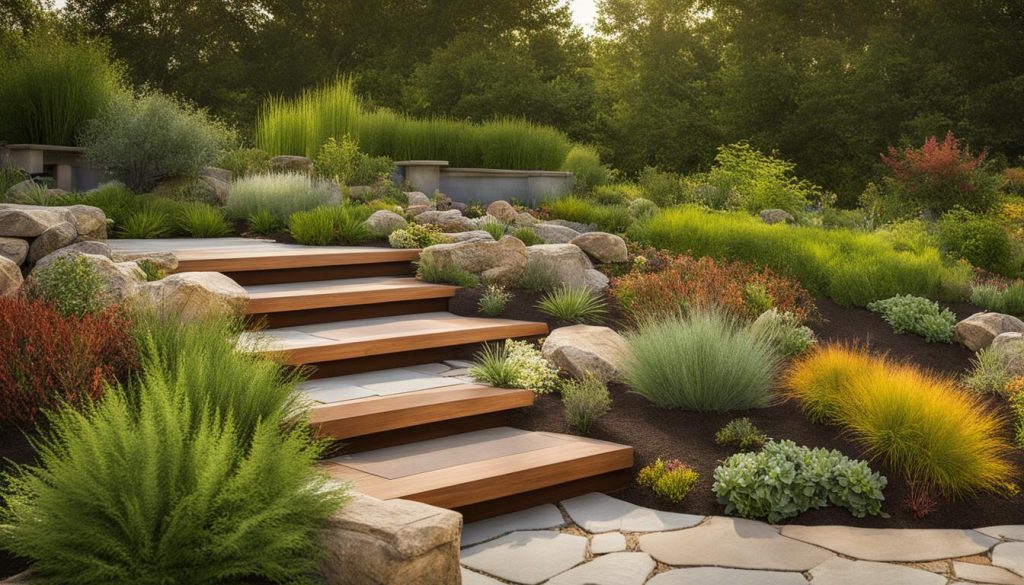
The next step involves assessing our space. We consider the size of our outdoor space, its topography, soil type, and existing vegetation. This information guides our plant selection and helps us determine how to best use our space optimally.
Once we have evaluated our space, we create a rough sketch that outlines the features we want to include in our design, such as pathways, garden beds, and outdoor living spaces. This is the time to assess how these features will look like and fit into our outdoor space.
Creating a Sustainable Landscape Design
The key to creating a sustainable landscape design is to incorporate design elements that promote environmental sustainability. We consider conserving energy, water, and other natural resources, and reducing waste in our design.
One way to achieve this is by using native plants that require less water and maintenance than non-native plants. Native plants are also more resistant to pests and diseases, reducing the need for pesticides and herbicides.
Another way to create a sustainable landscape design is by incorporating rainwater harvesting and other water conservation techniques. This helps us reduce our water consumption and minimize water waste.
By planning, we can create a sustainable landscape design that promotes environmental conservation and aligns with our outdoor space goals.
Choosing Native Plants and Drought-Tolerant Species
Incorporating native plants and drought-tolerant species is an essential aspect of any sustainable landscape design. These plants have adapted to the local climate and are more resistant to diseases and pests, reducing the need for chemicals and fertilizers.
Native plants provide a habitat for local wildlife, such as bees, butterflies, and birds, promoting biodiversity and enhancing the ecosystem. They also require less water, reducing the overall water consumption and promoting water conservation.
When selecting plants for your landscape, consider the region’s climate and soil conditions. Native plants are best suited for their specific region and will require less maintenance. Drought-tolerant species, such as succulents and cacti, are also great options for areas with limited water resources.
Benefits of Native Plants and Drought-Tolerant Species
- Require less water
- Reduce maintenance needs
- Promote biodiversity and ecosystem health
- Increase resistance to pests and diseases
- Provide a natural habitat for local wildlife
- Enhance the aesthetic appeal of the landscape
By choosing native plants and drought-tolerant species, you can create a sustainable landscape that is both beautiful and eco-friendly.
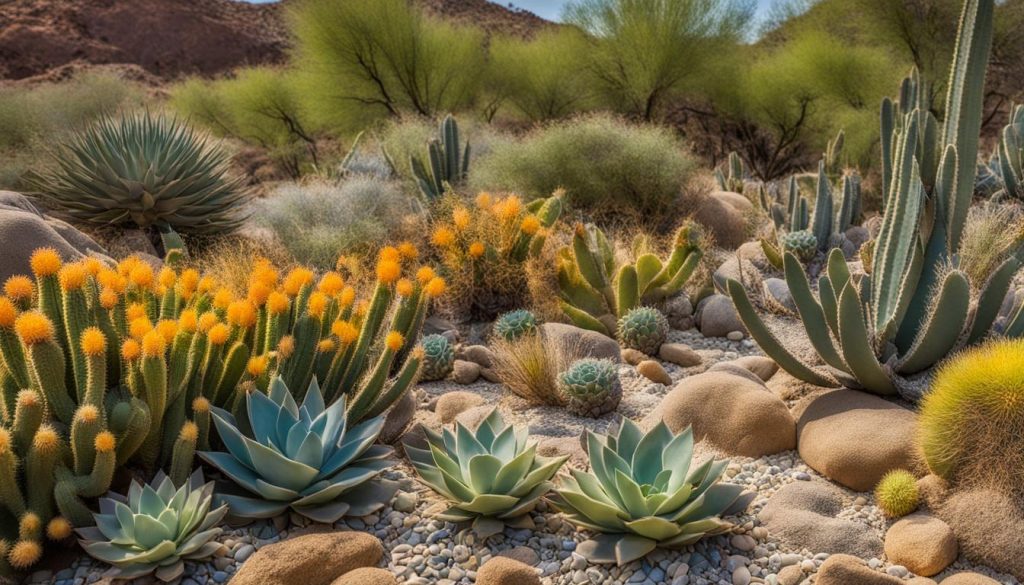
Implementing Efficient Irrigation Systems
We understand that water conservation is a crucial aspect of sustainable landscaping. That’s why we recommend incorporating efficient irrigation systems into your landscape design. By using appropriate irrigation systems, you not only conserve water but also reduce your water bill and energy consumption.
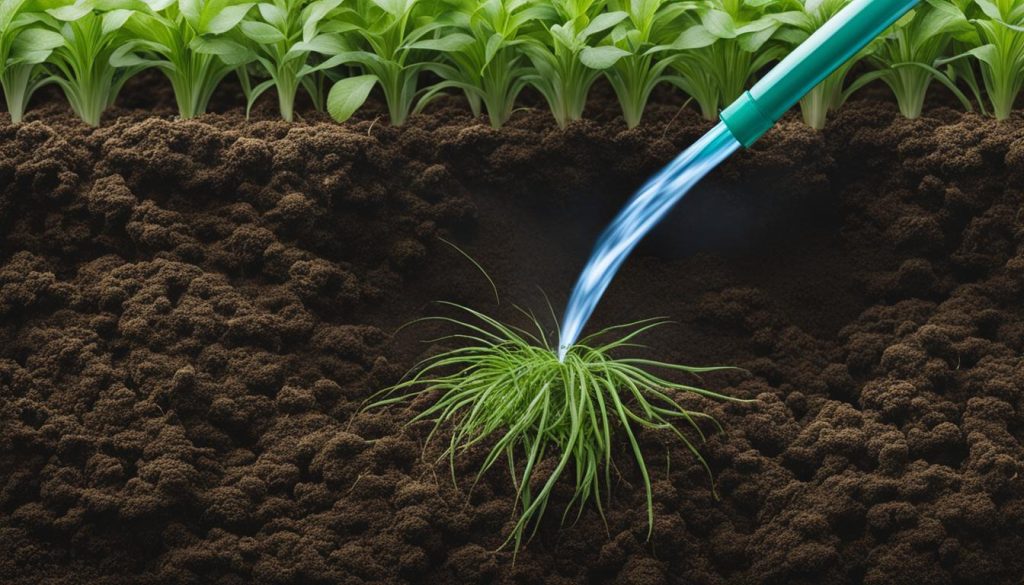
Drip irrigation is a popular method that has gained attention for its efficiency in watering plants. This system delivers water directly to the roots of plants, reducing water waste and minimizing evaporation. Plus, it reduces weed growth and prevents soil erosion.
Another effective method is rainwater harvesting. Collecting rainwater can provide an alternative source of water for your landscape, resulting in a lower demand for municipal water. The collected water can be used to water plants and trees, wash outdoor equipment, or even flush toilets.
We also recommend considering weather-based irrigation controllers. These controllers adjust the watering schedule based on current weather conditions, meaning you water only when necessary. This system is smart and can save you both water and money.
- Drip irrigation delivers water directly to the roots of plants.
- Rainwater harvesting reduces your demand for municipal water.
- Weather-based irrigation controllers adjust the watering schedule based on current weather conditions.
By implementing these efficient irrigation systems, you can reduce water usage, minimize waste, and save money. Plus, you can give your landscape the water it needs to thrive without compromising on sustainability.
Creating Natural Habitats and Wildlife-Friendly Features
Creating natural habitats and wildlife-friendly features is an essential aspect of sustainable landscaping. Not only does it benefit the ecosystem, but it also enhances the beauty and liveliness of your outdoor space.
Incorporating Native Plants
One of the best ways to attract wildlife to your landscape is by incorporating native plants. Native plants are those that naturally grow in your area and are adapted to the climate and soil conditions. They provide food and habitat for birds, bees, butterflies, and other wildlife. You can create a diverse and thriving natural habitat by planting a mix of trees, shrubs, flowers, and grasses. Some examples of popular native plants in Canada include the Eastern Redbud, Black-Eyed Susan, and Prairie Smoke.
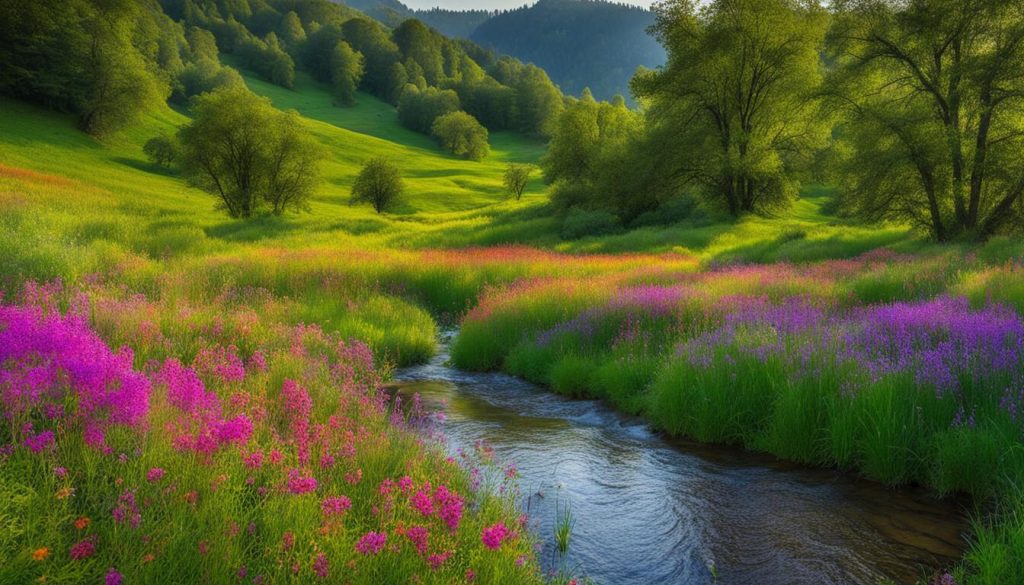
Installing Bird Feeders and Houses
Birds are an essential part of any ecosystem, and attracting them to your landscape can be both enjoyable and beneficial. Installing bird feeders and houses is an excellent way to create a welcoming environment for birds. You can choose from a variety of bird feeders, including tube feeders, hopper feeders, and suet feeders. When choosing a birdhouse, make sure it is specific to the bird species you want to attract.
Providing Water Sources
Providing water sources, such as a bird bath, fountain, or pond, is crucial for attracting wildlife. Birds and other animals need water to survive, and having a reliable water source in your landscape can increase the diversity of wildlife in your area. Make sure to keep the water source clean and free of debris to prevent the spread of disease.
Adding Butterfly Gardens
Butterflies play a vital role in pollination, and creating a butterfly garden in your landscape is an excellent way to attract them. Butterfly gardens typically feature a range of plants that provide nectar, as well as food for butterfly larvae. Some popular plants for butterfly gardens include milkweed, butterfly weed, and purple coneflower.
Creating Habitat Diversity
Creating habitat diversity is essential for promoting biodiversity in your landscape. You can do this by incorporating different types of plants, providing shelter, and creating various microhabitats. For example, you can add a log pile to provide a home for small animals, or create a rock garden to attract lizards and snakes.
Overall, creating natural habitats and wildlife-friendly features is an excellent way to promote sustainability in your landscape. By attracting wildlife, you can create a beautiful and thriving environment that benefits both you and the ecosystem.
Maintaining and Sustaining Your Sustainable Landscape
Congratulations! You have successfully created a sustainable landscape that aligns with the Canadian way of living. However, the work doesn’t stop there. To ensure the longevity of your outdoor space, you need to maintain and sustain it regularly. In this section, we will guide you through essential maintenance tasks and eco-friendly practices that will help you keep your sustainable landscape in pristine condition.
Essential Maintenance
Maintenance is a crucial aspect of sustaining your sustainable landscape. Regular upkeep will help prevent issues and keep your outdoor space looking beautiful. Here are some essential maintenance tasks to consider:
- Pruning and trimming: Regular pruning and trimming will help keep your plants healthy and promote growth.
- Pest control: Keep an eye out for pests that can harm your plants and use eco-friendly methods to address the problem.
- Soil management: Maintaining healthy soil is key to healthy plants. Consider adding compost and organic fertilizer to your soil regularly.
- Irrigation system maintenance: Regularly check your irrigation system for leaks or other issues.
Eco-Friendly Practices
In addition to maintenance tasks, there are many eco-friendly practices you can incorporate into your sustainable landscape to reduce your environmental impact. Here are some ideas:
- Composting: Instead of throwing away yard waste, start a compost pile. Compost will enrich your soil and reduce your need for chemical fertilizers.
- Chemical-free alternatives: Use natural solutions for pest control or weed management instead of chemical pesticides and herbicides.
- Reduce water usage: Consider using rainwater harvesting techniques or switching to drought-tolerant plants to reduce your water usage.
- Renewable energy sources: Consider incorporating solar lights or other renewable energy sources into your landscape design.
By incorporating these maintenance tasks and eco-friendly practices into your sustainable landscape, you can help sustain the beauty and functionality of your outdoor space for years to come.
Our landscapers at Landscaper Near Me are dedicated to executing quality work and providing outstanding customer service, every time. Contact us!
FAQ
How can I design a sustainable landscape for my outdoor space?
To design a sustainable landscape, start by assessing your outdoor space and setting goals. Consider incorporating native plants and drought-tolerant species, implementing efficient irrigation systems, creating natural habitats and wildlife-friendly features, and maintaining your landscape with eco-friendly practices.
How does sustainable landscaping align with the Canadian way of living?
Sustainable landscaping embraces green practices and aligns with the Canadian way of living. Canadians value preserving the environment and reducing their ecological footprint. By incorporating eco-friendly elements into your landscape design, you contribute to a more sustainable and environmentally conscious lifestyle.
What steps are involved in planning a sustainable landscape design?
Planning a sustainable landscape design involves assessing your space, setting goals, selecting native plants and drought-tolerant species, implementing efficient irrigation systems, creating natural habitats and wildlife-friendly features, and maintaining your landscape. Each step is crucial to ensure an environmentally-friendly and sustainable outdoor environment.
Why is it important to choose native plants and drought-tolerant species for a sustainable landscape?
Choosing native plants and drought-tolerant species is important for several reasons. Native plants are adapted to the local climate and soil conditions, requiring less water and maintenance. Drought-tolerant species are resilient during dry periods, reducing the need for excessive watering. By selecting these plants, you conserve water, promote biodiversity, and minimize maintenance in your sustainable landscape.
How can I incorporate efficient irrigation systems into my sustainable landscape design?
To incorporate efficient irrigation systems, consider methods such as drip irrigation and rainwater harvesting. Drip irrigation delivers water directly to the roots, minimizing water waste. Rainwater harvesting involves collecting and storing rainwater for later use in watering plants. These techniques optimize water usage and reduce water waste, making your landscape design more sustainable.
Why is it important to create natural habitats and wildlife-friendly features in a sustainable landscape?
Creating natural habitats and wildlife-friendly features in your sustainable landscape helps enhance the ecosystem and promote biodiversity. By attracting beneficial insects, birds, and other wildlife, you contribute to the overall health and balance of your outdoor environment. It also provides a more enjoyable and immersive experience with nature.
How can I maintain and sustain my sustainable landscape?
To maintain and sustain your sustainable landscape, perform essential maintenance tasks such as watering, pruning, and weeding. Use eco-friendly practices such as composting and using organic fertilizers. Regularly monitor your landscape for any signs of pests or diseases and address them with environmentally safe methods. By following these practices, you ensure the longevity of your outdoor space and its sustainable elements.

